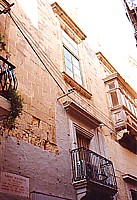<gerolamo
cassar and his architectural influences
- article published in The Sunday Times of Malta on August 8th, 1999 -
 |
Due to a lack of documentary proof, it has always been a controversial question whether Gerolamo Cassar, architect of buildings like St. John’s Co-Cathedral, the Grandmaster Palace and the auberges in Valletta, went on a study tour to Italy. One day after being appointed a serving brother of the Italian Langue of the Order, on April 23rd, 1569, Cassar was probably sent to Italy by Grandmaster Pietro del Monte. He was supposed to visit Rome, Naples and other parts of the country to inform himself about the latest building styles and to get a first hand impression of the modern Italian architecture. But whether Cassar actually went on this study tour is not known. |
| sent to italy to study renaissance architecture: gerolamo cassar |
The only way to clarify this matter is a close examination of the contemporary architecture in Italy, especially in Rome and Naples, and a comparison of the Italian buildings with Cassar’s buildings in Malta. However, there are various influences and conditions that were relevant for Cassar when he designed the numerous buildings for the Order of St. John.
|
First of all, he was certainly influenced by Malta’s own medieval architecture, like the old Mdina Cathedral (destroyed in 1693) and the Dominican Church in Birgu (destroyed in the Second World War) with their campanili, which resemble the western towers of Cassar’s St. John’s Co-Cathedral. The Birgu auberges, all built shortly after the Knights’ arrival in Malta in 1530, probably gave Cassar, who was so far inexperienced with the designing of secular architecture, some basic ideas for his designs. The plain and rather austere facades as well as some other architectural features, such as the window frames (with the “Melitan triple roll moulding”) and the barrel-vaulted entrance hall (see Auberge de France), can also be found at Cassar’s auberges in Valletta. |
 |
|
the tower of st. john's co-cathedral resembles the campanili of the old mdina parish church and of the dominican church in birgu |
 |
The Knights’ architectural knowledge and their instructions were also relevant for Cassar’s work. They had already gained some practical knowledge in constructing and designing from their former headquarter in Rhodes, and therefore, they probably gave Cassar advises and assisted him in the construction of his buildings. Some structural elements, like the timber beams and consoles of the ceilings in the Piano Nobile of the Grandmaster Palace and the slightly pitched barrel-vaults of the churches, can be found in both Rhodes and Malta.
|
| erected by the knights of st. john: the auberges in birgu |
|
Due to the Order’s conditions and instructions, Cassar was also restricted in his designs and his creativity. His buildings were supposed to be plain, with almost no decoration and determined by their function. This austere building style reflects and symbolizes the religious and military character of the Order of St. John (see, for example, the towers of St. John’s Co-Cathedral, of Verdala Palace and the rusticated corners of the auberges in Valletta). Moreover, Cassar had to stick to the building laws by the Officio delle Case. Valletta’s street layout was another obstacle for Cassar, who had to find suitable sites for the various buildings of the Knights. |
|
|
especially verdala palace shows the military character of the knights' building style |